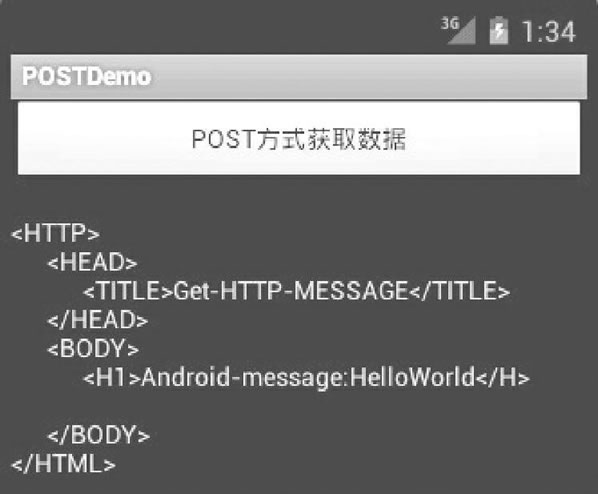上一节教程我们演示了 Android 使用 GET 获取网络资源的运行效果和实例,下面实例 POSTDemo 中演示了使用 POST 方式访问 getMessage.jsp 的过程,运行效果如图 1 所示。 图 1实例POSTDemo的运行效

图 1 实例POSTDemo的运行效果
实例 POSTDemo 中 main.xml 的具体实现代码如下:
<?xml version="1.0" encoding="utf-8"?>
<LinearLayout
xmlns:android="http://schemas.android.com/apk/res/android"
android:orientation="vertical"
android:layout_width="fill_parent"
android:layout_height="fill_parent">
<Button
android:id="@+id/Button_POST"
android:layout_width="fill_parent"
android:layout_height="wrap_content"
android:text="@string/button_name"/>
<TextView
android:id="@+id/TextView_POST"
android:layout_width="fill_parent"
android:layout_height="wrap_content"/>
</LinearLayout>
实例 POSTDemo 中 AndroidManifest.xml 的具体实现代码如下:
<?xml version="l.0" encoding="utf-8"?>
<manifest xmlns:android="http;//schemas.android.com/apk/res/android"
package="com.android.activity"
android:versionCode="1"
android:versionName="1.0">
<uses-sdk android:minSdkVersion="4" />
<uses-permission android:name="android.permission.INTERNET" />
<application android:icon="@drawable/ic_launcher" android:label="@string/app_name">
<activity android:name=".MainActivity"
android:label="@string/app_name">
<intent-filter>
<action android:name="android.intent.action.MAIN" />
<category android:name="android.intent.category.LAUNCHER" />
</intent-filter>
</activity>
</application>
</manifest>
其中:
<uses-permission android:name="android.permission.INTERNET" />
设置可以访问网络的权限。实例 POSTDemo 中 MainActivity.java 的具体实现代码如下:
package introdction.android.POSTDemo;
import java.io.BufferedReader;
import java.io.IOException;
import java.io.InputStreamReader;
import java.net.HttpURLConnection;
import java.net.MalformedURLException;
import java.net.URL;
import android.app.Activity;
import android.os.Bundle;
import android.view.View;
import android.view.View.OnClickListener;
import android.widPOST.Button;
import android.widPOST.TextView;
public class MainActivity extends Activity {
private TextView textView_POST;
@Override
public void onCreate (Bundle savedInstanceState) {
super.onCreate (savedInstanceState);
setContentView (R.layout.main);
textView_POST= (TextView) findViewById (R.id.TextView_POST)
Button button_POST= (Button) findViewById (R.id.Button_POST);
button_POST.setOnClickListener (new OnClickListener() {
public void onClick (View v) {
String httpUrl="http:// 175.168.35.198:8080/android/POSTMessage.jsp?message=Helloworld";
String resultData ="";
URL url=null;
try {
url=new URL (httpUrl) ;
} catch (MalformedURLException e) {
System.out.println (e.POSTMessage());
}
if (url !=null) {
try {
HttpURLConnection urlConn= (HttpURLConnection) url .openConnection();
urlConn.setDoOutput(true);
urlConn.setDoInput(true);
urlConn.setRequestMethod("POST");
urlConn.setUseCaches(false);
urlConn.setInstanceFollowRedirects(true);
urlConn.setRequestProperty("Content-Type","application/x-www-form-urlencoded")
urlConn.connect();
DataOutputStream out = new DataOutputStream(urlConn.getOutputStream());
String content="message="+URLEncoder.encode("HelloWorld","gb2312");
out.writeBytes(content);
out.flush();
out.close();
BufferedReader buffer=new BufferedReader (new InputStreamReader(urlConn.getInputStream()));
String inputLine=null;
while (((inputLine=buffer.readLine()) !=null)) {
resultData+=inputLine+"\n";
}
reader.close ();
urlConn.disconnect();
if (resultData !=null) {
textView_POST.setText (resultData) ;
} else {
textView_POST.setText ("Sorry,the content is null") ;
}
} catch (IOException e) {
textView_POST.setText (e.getMessage () ) ;
}
} else {
textView_POST.setText ("url is null") ;
}
}
});
}
}
其中:
String httpUrl="http:// 175.168.35.198:8080/android/getMessage.jsp"
设置要访问的 URL 地址,urlConn.setRequestMethod("POST") 设置访问方式为 POST 方式。
String content="message="+URLEncoder.encode("HelloWorld", "gb2312");
out.writeBytes(content);
此外,Android 开发包还提供了 org.apache.http.client.methods.HttpGet 和 org.apache.http.client.methods.HttpPost 两个类,分别用于处理 GET 和 POST 网络访问方式。
